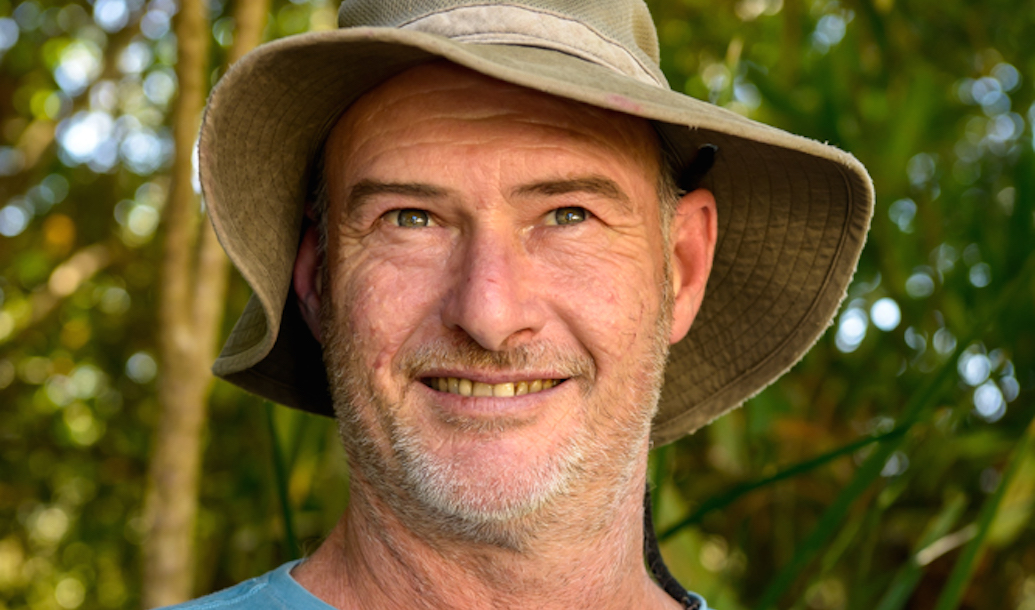Growing up on the edge of the bush in Sydney’s northern beaches, Darren developed an early passion for wild places. School holidays to the Northern Rivers included several hikes to Wollumbin National Park and drives through the Border Ranges which sparked a keen interest in rainforest botany. That interest transformed into action in the mid-80s when the Queensland government decided to push a new road through the rainforest at Cape Tribulation, setting Darren on a path committed to rainforest conservation.
Darren enrolled in a Bachelor of Applied Science at Southern Cross University and arrived in Lismore by train in 1989 with nothing more than a backpack and a push bike. He learnt a lot about the surrounding area during the course and made good connections with like-minded people. Darren started working for Firewheel Rainforest Nursery in 1991 at the same time as finishing uni and doing a bush regeneration course at TAFE. Drawing on the knowledge of the rainforest regeneration pioneers of the region such as Mark Dunphy, John Nagle, Rosemary Joseph, Mike Delaney and Ralph Woodford helped to fast track the experience. Darren started working on the property of Tony Parkes at Binna Burra in the mid 90’s planting thousands of rainforest trees using the models established by these early practitioners.
It was Tony Parkes that spearheaded the formation of Big Scrub Landcare, now Big Scrub Rainforest Conservancy, to give direction to these early rainforest restoration efforts as well as establish an organised group that could manage environmental grants and distribute the funds where it was needed. We started working to restore some of the iconic Big Scrub rainforest remnants like Dawes Bush, Booyong Flora Reserve, Hermans Scrub, Hogans Bluff, Emerys Scrub and Maguires Ck in 1997 with small grants obtained by the landcare group. These sites were full of environmental weeds back then and had a history of neglect and cattle incursion. Climbing asparagus, Japanese honeysuckle, large-leaved privet, trad and madeira vine were common weed problems at these sites. These weed infestations competed with the rainforest on its edges and often blocked the normal recovery of tree fall gaps observed in wilderness areas.

Darren planting endangered Nightcap Oak seedlings as part of the threatened species’ recovery program.
The Landcare group fenced off many of the remnants and planted out the resultant edges to increase the size of the sites. Numerous 6-month-long Green Corps crews were deployed to work with experienced bush regenerators like Jen Ford and Mike Delaney. These guys did the bulk of the initial work on the Big Scrub remnant sites while Darren and his early bush regeneration team did the follow up and site maintenance work to ensure that weeds did not re-establish. Darren worked alongside many different bush regenerators over these years including Hank and Sue Bower, Dave Conder, Hamish Cobbett, Stuart Macdonald and Mark Evans all of whom have gone on to become some of the best restoration ecologists in the Big Scrub area and beyond.
Darren continues to work on around 20 of the Big Scrub remnants, maintaining the core areas of rainforest and expanding the sites on their edges. Darren works with an excellent team of bush regenerators that have been consistently working in the Big Scrub for more than 25 years. It’s been a real pleasure for Darren to witness the condition of the sites change and improve over time with large gaps of lantana, stands of privet, and plumes of madeira and moth vine now mostly occupied by rainforest. Ground layer infestations of exotic grasses and weeds, like trad, have been reduced to minor levels and have often been replaced by native ferns and other groundcovers. Big stands of camphor laurel that originally adjoined rainforest remnants like Emerys Scrub and Killen Falls have now been converted to regrowth rainforest significantly increasing the size of the sites and their overall biodiversity. Numerous threatened plant species such as isoglossa, thorny pea, rainforest senna and brush sauropus have increased in population over time and expanded to grow in areas that were originally dominated by weeds.
There is always more work to be done on the Big Scrub rainforest remnants. Sunny edges and creek banks are prime areas for weed growth and new tree fall gaps create situations for weeds to establish even in largely intact sites like Booyong and Johnstons Scrub. The remnants are always changing with weeds like corky passionfruit and giant devil’s fig becoming more common around the edges of many sites over time.
The environmental restoration industry in northern NSW has come a long way in the last 30 years. From relatively small beginnings there are now hundreds of bush regenerators working day in, day out on many varied projects. This amounts to landscape level improvements of rainforest vegetation and environmental outcomes, to which Darren’s contribution has been invaluable. We look forward to seeing the continuing impact of his fantastic work.


